technical data SKODA FABIA 2003 1.G / 6Y Repair Manual
[x] Cancel search | Manufacturer: SKODA, Model Year: 2003, Model line: FABIA, Model: SKODA FABIA 2003 1.G / 6YPages: 233, PDF Size: 32.04 MB
Page 126 of 233
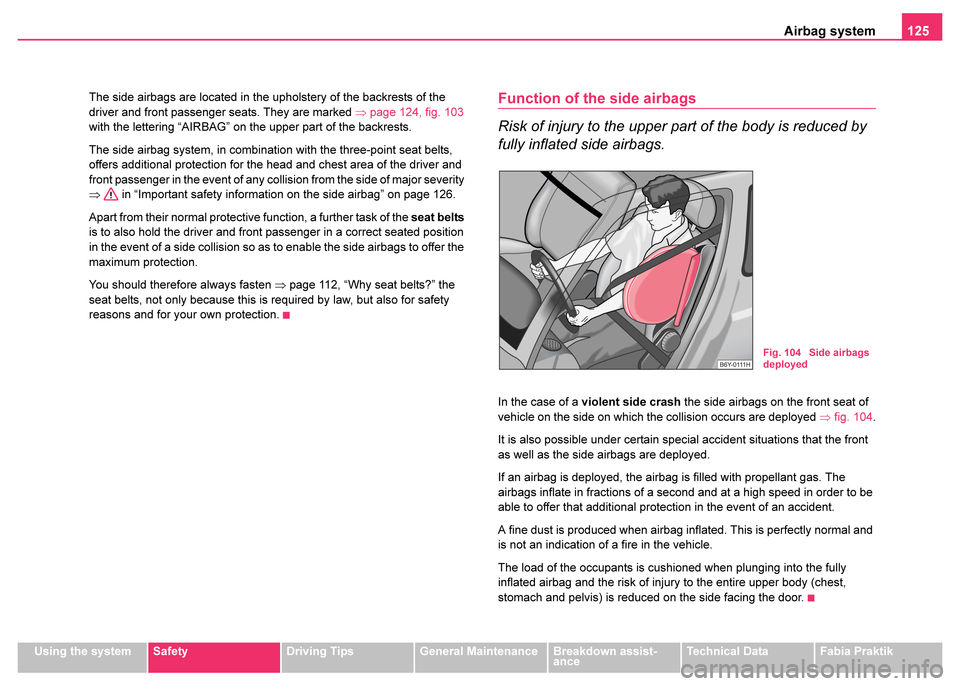
Airbag system125
Using the systemSafetyDriving TipsGeneral MaintenanceBreakdown assist-
anceTechnical DataFabia Praktik
The side airbags are located in the upholstery of the backrests of the
driver and front passenger seats. They are marked
⇒page 124, fig. 103
with the lettering “AIRBAG” on the upper part of the backrests.
The side airbag system, in combination with the three-point seat belts,
offers additional protection for the head and chest area of the driver and
front passenger in the event of any collision from the side of major severity
⇒ in “Important safety information on the side airbag” on page 126.
Apart from their normal protective function, a further task of the seat belts
is to also hold the driver and front passenger in a correct seated position
in the event of a side collision so as to enable the side airbags to offer the
maximum protection.
You should therefore always fasten ⇒page 112, “Why seat belts?” the
seat belts, not only because this is required by law, but also for safety
reasons and for your own protection.
Function of the side airbags
Risk of injury to the upper part of the body is reduced by
fully inflated side airbags.
In the case of a violent side crash the side airbags on the front seat of
vehicle on the side on which the collision occurs are deployed ⇒fig. 104.
It is also possible under certain special accident situations that the front
as well as the side airbags are deployed.
If an airbag is deployed, the airbag is filled with propellant gas. The
airbags inflate in fractions of a second and at a high speed in order to be
able to offer that additional protection in the event of an accident.
A fine dust is produced when airbag inflated. This is perfectly normal and
is not an indication of a fire in the vehicle.
The load of the occupants is cushioned when plunging into the fully
inflated airbag and the risk of injury to the entire upper body (chest,
stomach and pelvis) is reduced on the side facing the door.
Fig. 104 Side airbags
deployed
Page 128 of 233
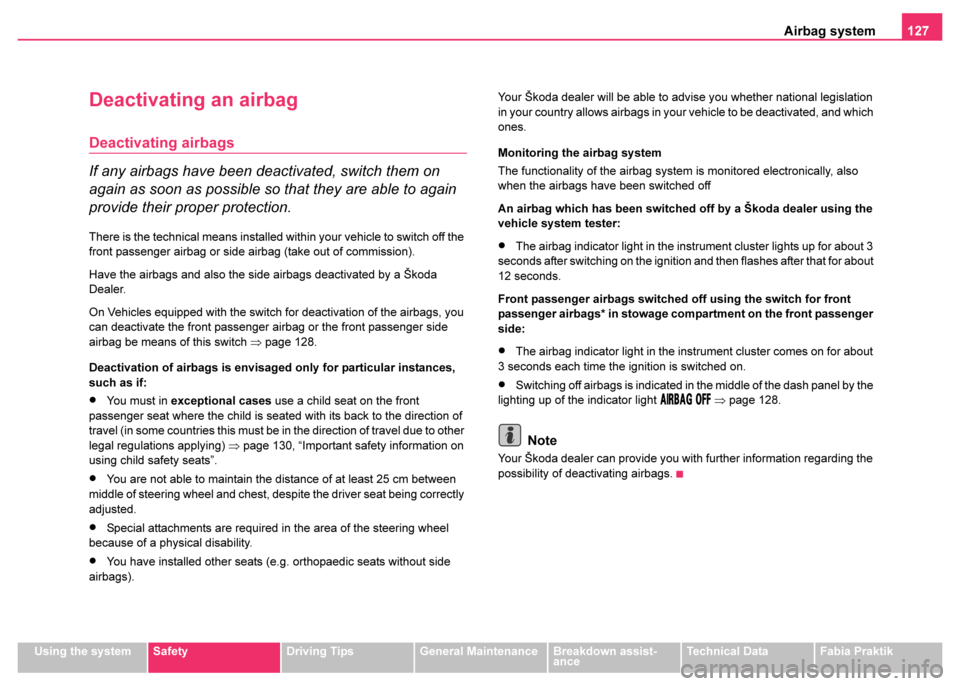
Airbag system127
Using the systemSafetyDriving TipsGeneral MaintenanceBreakdown assist-
anceTechnical DataFabia Praktik
Deactivating an airbag
Deactivating airbags
If any airbags have been deactivated, switch them on
again as soon as possible so that they are able to again
provide their proper protection.
There is the technical means installed within your vehicle to switch off the
front passenger airbag or side airbag (take out of commission).
Have the airbags and also the side airbags deactivated by a Škoda
Dealer.
On Vehicles equipped with the switch for deactivation of the airbags, you
can deactivate the front passenger airbag or the front passenger side
airbag be means of this switch ⇒page 128.
Deactivation of airbags is envisaged only for particular instances,
such as if:
•You must in exceptional cases use a child seat on the front
passenger seat where the child is seated with its back to the direction of
travel (in some countries this must be in the direction of travel due to other
legal regulations applying) ⇒ page 130, “Important safety information on
using child safety seats”.
•You are not able to maintain the distance of at least 25 cm between
middle of steering wheel and chest, despite the driver seat being correctly
adjusted.
•Special attachments are required in the area of the steering wheel
because of a physical disability.
•You have installed other seats (e.g. orthopaedic seats without side
airbags). Your Škoda dealer will be able to advise you whether national legislation
in your country allows airbags in your vehicle to be deactivated, and which
ones.
Monitoring the airbag system
The functionality of the airbag system is monitored electronically, also
when the airbags have been switched off
An airbag which has been switched off by a Škoda dealer using the
vehicle system tester:
•The airbag indicator light in the instrument cluster lights up for about 3
seconds after switching on the ignition and then flashes after that for about
12 seconds.
Front passenger airbags switched off using the switch for front
passenger airbags* in stowage compartment on the front passenger
side:
•The airbag indicator light in the instrument cluster comes on for about
3 seconds each time the ignition is switched on.
•Switching off airbags is indicated in the middle of the dash panel by the
lighting up of the indicator light ⇒ page 128.
Note
Your Škoda dealer can provide you with further information regarding the
possibility of deactivating airbags.
Page 130 of 233
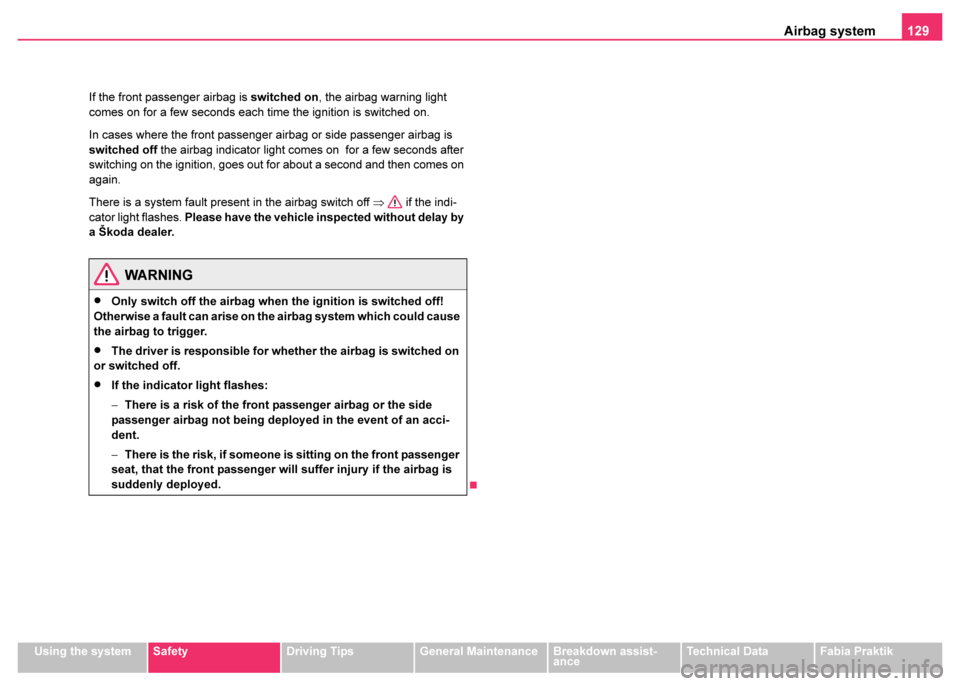
Airbag system129
Using the systemSafetyDriving TipsGeneral MaintenanceBreakdown assist-
anceTechnical DataFabia Praktik
If the front passenger airbag is
switched on, the airbag warning light
comes on for a few seconds each time the ignition is switched on.
In cases where the front passenger airbag or side passenger airbag is
switched off the airbag indicator light comes on for a few seconds after
switching on the ignition, goes out for about a second and then comes on
again.
There is a system fault present in the airbag switch off ⇒ if the indi-
cator light flashes. Please have the vehicle inspected without delay by
a Škoda dealer.
WARNING
•Only switch off the airbag when the ignition is switched off!
Otherwise a fault can arise on the airbag system which could cause
the airbag to trigger.
•The driver is responsible for whether the airbag is switched on
or switched off.
•If the indicator light flashes:
− There is a risk of the front passenger airbag or the side
passenger airbag not being deployed in the event of an acci-
dent.
− There is the risk, if someone is sitting on the front passenger
seat, that the front passenger will suffer injury if the airbag is
suddenly deployed.
Page 132 of 233
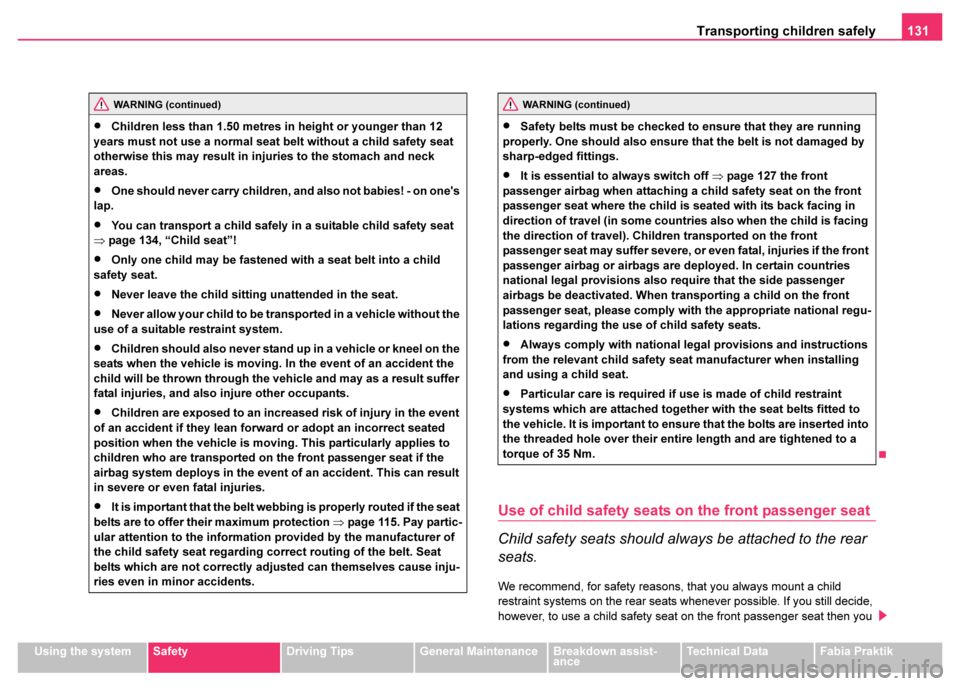
Transporting children safely131
Using the systemSafetyDriving TipsGeneral MaintenanceBreakdown assist-
anceTechnical DataFabia Praktik
Use of child safety seats on the front passenger seat
Child safety seats should always be attached to the rear
seats.
We recommend, for safety reasons, that you always mount a child
restraint systems on the rear seats whenever possible. If you still decide,
however, to use a child safety seat on the front passenger seat then you
WARNING (continued)
•Children less than 1.50 metres in height or younger than 12
years must not use a normal seat belt without a child safety seat
otherwise this may result in injuries to the stomach and neck
areas.
•One should never carry children, and also not babies! - on one's
lap.
•You can transport a child safely in a suitable child safety seat
⇒ page 134, “Child seat”!
•Only one child may be fastened with a seat belt into a child
safety seat.
•Never leave the child sitting unattended in the seat.
•Never allow your child to be transported in a vehicle without the
use of a suitable restraint system.
•Children should also never stand up in a vehicle or kneel on the
seats when the vehicle is moving. In the event of an accident the
child will be thrown through the vehicle and may as a result suffer
fatal injuries, and also injure other occupants.
•Children are exposed to an increased risk of injury in the event
of an accident if they lean forward or adopt an incorrect seated
position when the vehicle is moving. This particularly applies to
children who are transported on the front passenger seat if the
airbag system deploys in the event of an accident. This can result
in severe or even fatal injuries.
•It is important that the belt webbing is properly routed if the seat
belts are to offer their maximum protection ⇒page 115. Pay partic-
ular attention to the information provided by the manufacturer of
the child safety seat regarding correct routing of the belt. Seat
belts which are not correctly adjusted can themselves cause inju-
ries even in minor accidents.
WARNING (continued)
•Safety belts must be checked to ensure that they are running
properly. One should also ensure that the belt is not damaged by
sharp-edged fittings.
•It is essential to always switch off ⇒page 127 the front
passenger airbag when attaching a child safety seat on the front
passenger seat where the child is seated with its back facing in
direction of travel (in some countries also when the child is facing
the direction of travel). Children transported on the front
passenger seat may suffer severe, or even fatal, injuries if the front
passenger airbag or airbags are deployed. In certain countries
national legal provisions also require that the side passenger
airbags be deactivated. When transporting a child on the front
passenger seat, please comply with the appropriate national regu-
lations regarding the use of child safety seats.
•Always comply with national legal provisions and instructions
from the relevant child safety seat manufacturer when installing
and using a child seat.
•Particular care is required if use is made of child restraint
systems which are attached together with the seat belts fitted to
the vehicle. It is important to ensure that the bolts are inserted into
the threaded hole over their entire length and are tightened to a
torque of 35 Nm.
Page 134 of 233

Transporting children safely133
Using the systemSafetyDriving TipsGeneral MaintenanceBreakdown assist-
anceTechnical DataFabia Praktik
Child safety and side airbags*
Children must never be seated in the deployment area of
side airbags.Side airbags* offer the vehicle occupants enhanced protection in the
event of a collision from the side.
The side airbags are inflated in fractions of a second in order to be able to
provide this protection ⇒page 125, “Function of the side airbags”.
An airbag inflating develops such a strong force that an occupant who has
not adopted an upright seated position may suffer injuries from the airbag
or as a result of objects which are located within the deployment area of
the side airbag.
This applies particularly to children if they are not transported in
accordance with legal requirements.
The child is protected when seated in a child safety seat matching its age.
Adequate room is available between the child and the deployment area of
the side airbag and head airbag. The side airbag offers optimal protection.
Fig. 107 Seated posi-
tion of an unprotected
child at risk from side
airbag
Fig. 108 Child properly
protected by safety
seat
WARNING
•It is essential to always switch off ⇒page 127 the front
passenger airbag when attaching a child safety seat on the front
passenger seat where the child is seated with its back facing in
direction of travel (in some countries also when the child is facing
the direction of travel). Children transported on the front
passenger seat may suffer severe, or even fatal, injuries if the front
passenger airbag or airbags are deployed. In certain countries
national legal provisions also require that the side passenger
airbags be deactivated. When transporting a child on the front
passenger seat, please comply with the appropriate national regu-
lations regarding the use of child safety seats.
•When transporting a child on the front passenger seat, please
comply with the appropriate national regulations regarding the use
of child safety seats.
•Children must never be seated with their head in the deploy-
ment area of the side airbag. Risk of injury!
Page 136 of 233

Transporting children safely135
Using the systemSafetyDriving TipsGeneral MaintenanceBreakdown assist-
anceTechnical DataFabia Praktik
The optimal solution for babies of up to about 9 months old weighing up
to 10 kg or babies up to about 18 months old weighing up to 13 kg is a
child safety seat which can be adjusted into the reclining position
⇒
page 134, fig. 109 .
Child seats in which the child is facing with its back towards the
direction of travel should not be used on the front passenger seat
when the vehicle is fitted with a front passenger airbag ⇒ page 131,
“Use of child safety seats on the front passenger seat”
Child safety seats in Group 1
Child seats in Group 1 are for babies and small children up to 4 years of
age with a weight of between 9 and 18 kilograms. It is best for children in
the lower range of this group, to use a child seat which allows the child to
sit with its back to the direction of travel. It is best for children in the upper
range of the Group 0+, to use a child seat which allows the child to sit
⇒ fig. 110 in the direction of travel.
Child seats in which the child is facing with its back towards the
direction of travel should not be used on the front passenger seat
when the vehicle is fitted with a front passenger airbag ⇒ page 131,
“Use of child safety seats on the front passenger seat”
WARNING
•It is essential to always switch off the front passenger airbag
(airbags) when attaching in exceptional circumstances a child
safety seat on the front passenger seat where the child is seated
with its back facing in direction of travel (in some countries also
when the child is facing the direction of travel).
−by allowing a Skoda dealer to do this
− or by using the switch for the front seat passenger airbag*
⇒ page 128.
•The national legal provisions in certain countries require that
both the front and side passenger airbags be deactivated. Please
comply with any difffering national legal regulations regarding the
use of child safety seats.
•If this is not done, a child seated on the front passenger seat
may suffer severe or even fatal injuries if the front passenger
airbag or airbags are deployed.
•You should have the front passenger airbag (or airbags) reacti-
vated by your Škoda dealer just as soon as you no longer use a
child safety seat on the front passenger seat.
Fig. 110 Child seat
with padded table in
Group 1 installed on
rear seat bench facing
the direction of travel
Page 138 of 233
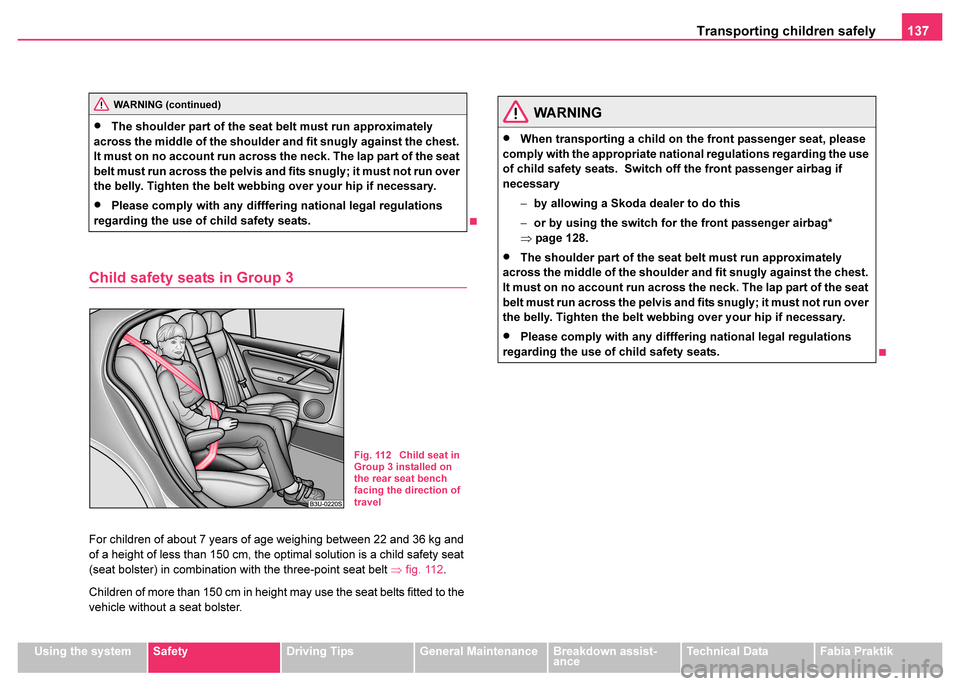
Transporting children safely137
Using the systemSafetyDriving TipsGeneral MaintenanceBreakdown assist-
anceTechnical DataFabia Praktik
Child safety seats in Group 3
For children of about 7 years of age weighing between 22 and 36 kg and
of a height of less than 150 cm, the optimal solution is a child safety seat
(seat bolster) in combination with the three-point seat belt ⇒fig. 112.
Children of more than 150 cm in height may use the seat belts fitted to the
vehicle without a seat bolster.
WARNING (continued)
•The shoulder part of the seat belt must run approximately
across the middle of the shoulder and fit snugly against the chest.
It must on no account run across the neck. The lap part of the seat
belt must run across the pelvis and fits snugly; it must not run over
the belly. Tighten the belt webbing over your hip if necessary.
•Please comply with any difffering national legal regulations
regarding the use of child safety seats.
Fig. 112 Child seat in
Group 3 installed on
the rear seat bench
facing the direction of
travel
WARNING
•When transporting a child on the front passenger seat, please
comply with the appropriate national regulations regarding the use
of child safety seats. Switch off the front passenger airbag if
necessary
−by allowing a Skoda dealer to do this
− or by using the switch for the front passenger airbag*
⇒ page 128.
•The shoulder part of the seat belt must run approximately
across the middle of the shoulder and fit snugly against the chest.
It must on no account run across the neck. The lap part of the seat
belt must run across the pelvis and fits snugly; it must not run over
the belly. Tighten the belt webbing over your hip if necessary.
•Please comply with any difffering national legal regulations
regarding the use of child safety seats.
Page 140 of 233
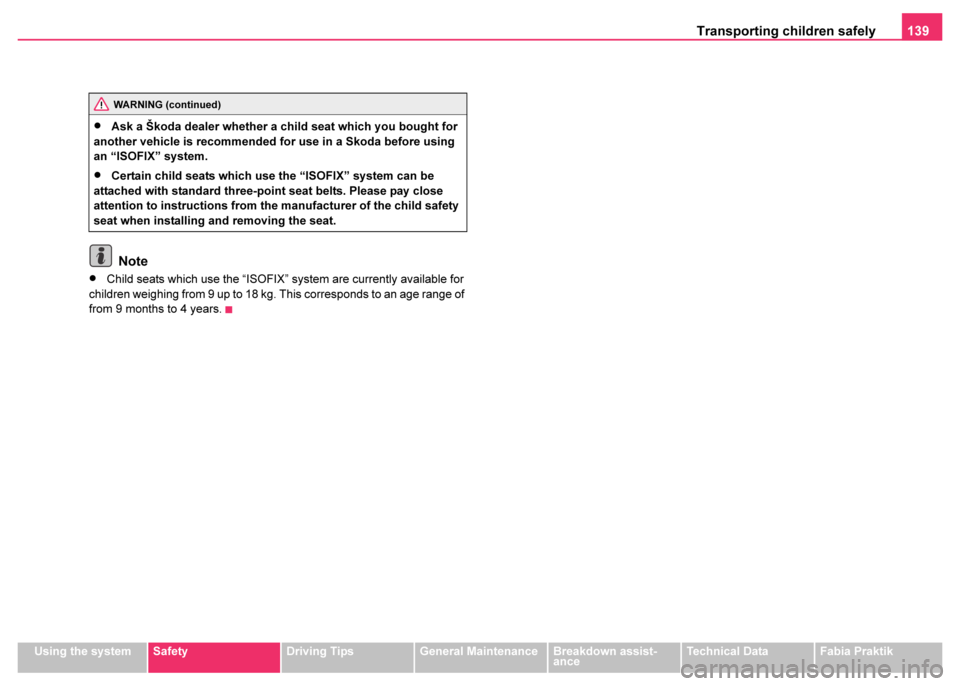
Transporting children safely139
Using the systemSafetyDriving TipsGeneral MaintenanceBreakdown assist-
anceTechnical DataFabia Praktik
Note
•Child seats which use the “ISOFIX” system are currently available for
children weighing from 9 up to 18 kg. This corresponds to an age range of
from 9 months to 4 years.
WARNING (continued)
•Ask a Škoda dealer whether a child seat which you bought for
another vehicle is recommended for use in a Skoda before using
an “ISOFIX” system.
•Certain child seats which use the “ISOFIX” system can be
attached with standard three-point seat belts. Please pay close
attention to instructions from the manufacturer of the child safety
seat when installing and removing the seat.
Page 142 of 233
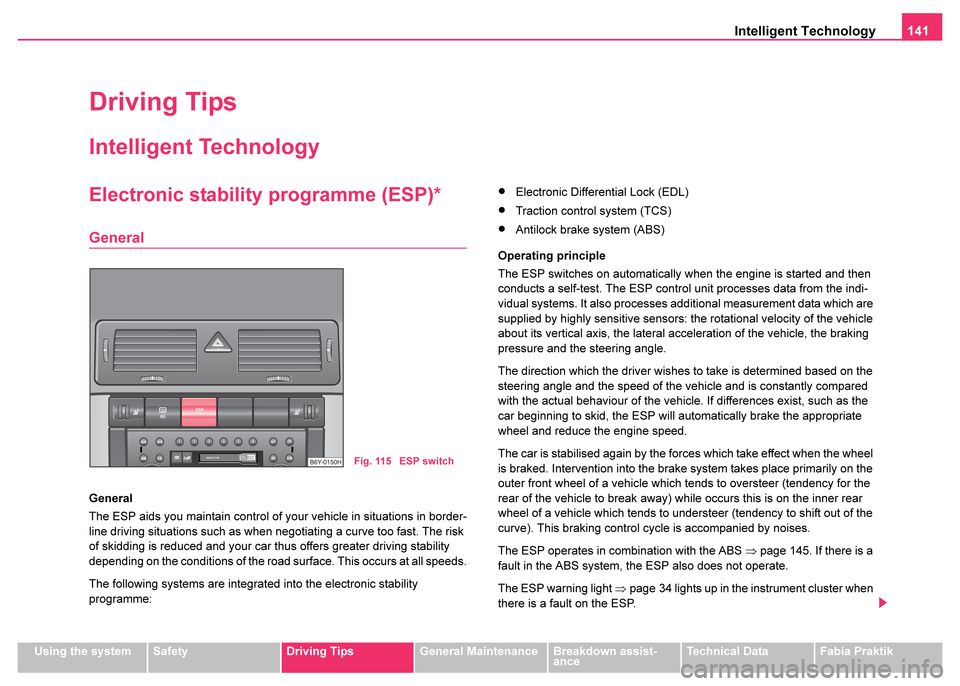
Intelligent Technology141
Using the systemSafetyDriving TipsGeneral MaintenanceBreakdown assist-
anceTechnical DataFabia Praktik
Driving Tips
Intelligent Technology
Electronic stability programme (ESP)*
General
General
The ESP aids you maintain control of your vehicle in situations in border-
line driving situations such as when negotiating a curve too fast. The risk
of skidding is reduced and your car thus offers greater driving stability
depending on the conditions of the road surface. This occurs at all speeds.
The following systems are integrated into the electronic stability
programme:
•Electronic Differential Lock (EDL)
•Traction control system (TCS)
•Antilock brake system (ABS)
Operating principle
The ESP switches on automatically when the engine is started and then
conducts a self-test. The ESP control unit processes data from the indi-
vidual systems. It also processes additional measurement data which are
supplied by highly sensitive sensors: the rotational velocity of the vehicle
about its vertical axis, the lateral acceleration of the vehicle, the braking
pressure and the steering angle.
The direction which the driver wishes to take is determined based on the
steering angle and the speed of the vehicle and is constantly compared
with the actual behaviour of the vehicle. If differences exist, such as the
car beginning to skid, the ESP will automatically brake the appropriate
wheel and reduce the engine speed.
The car is stabilised again by the forces which take effect when the wheel
is braked. Intervention into the brake system takes place primarily on the
outer front wheel of a vehicle which tends to oversteer (tendency for the
rear of the vehicle to break away) while occurs this is on the inner rear
wheel of a vehicle which tends to understeer (tendency to shift out of the
curve). This braking control cycle is accompanied by noises.
The ESP operates in combination with the ABS ⇒page 145. If there is a
fault in the ABS system, the ESP also does not operate.
The ESP warning light ⇒page 34 lights up in the instrument cluster when
there is a fault on the ESP.
Fig. 115 ESP switch
Page 144 of 233
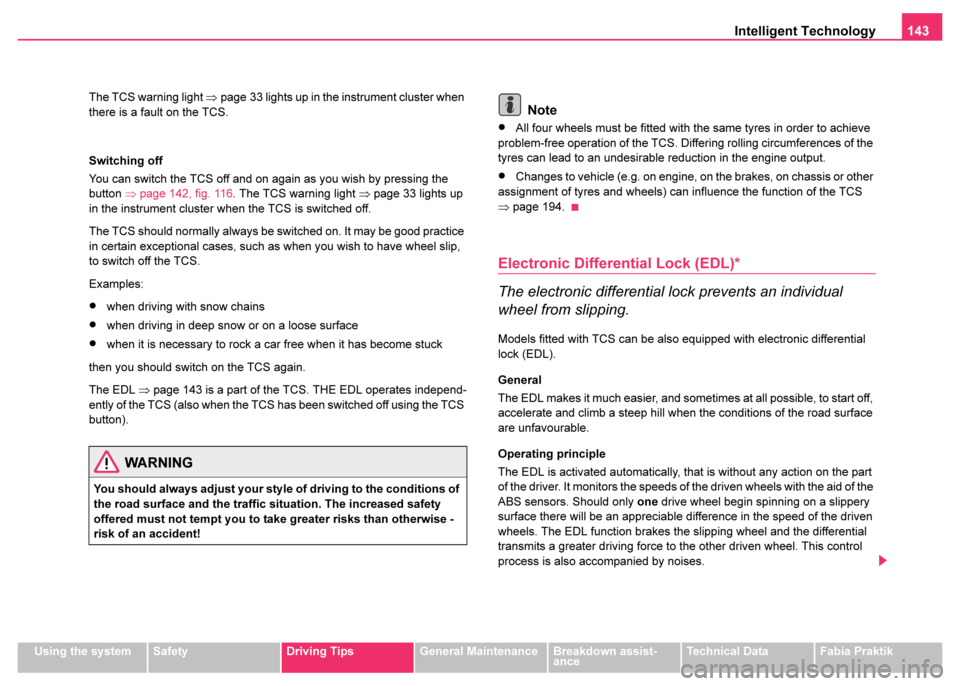
Intelligent Technology143
Using the systemSafetyDriving TipsGeneral MaintenanceBreakdown assist-
anceTechnical DataFabia Praktik
The TCS warning light
⇒page 33 lights up in the instrument cluster when
there is a fault on the TCS.
Switching off
You can switch the TCS off and on again as you wish by pressing the
button ⇒page 142, fig. 116 . The TCS warning light ⇒page 33 lights up
in the instrument cluster when the TCS is switched off.
The TCS should normally always be switched on. It may be good practice
in certain exceptional cases, such as when you wish to have wheel slip,
to switch off the TCS.
Examples:
•when driving with snow chains
•when driving in deep snow or on a loose surface
•when it is necessary to rock a car free when it has become stuck
then you should switch on the TCS again.
The EDL ⇒page 143 is a part of the TCS. THE EDL operates independ-
ently of the TCS (also when the TCS has been switched off using the TCS
button).
Note
•All four wheels must be fitted with the same tyres in order to achieve
problem-free operation of the TCS. Differing rolling circumferences of the
tyres can lead to an undesirable reduction in the engine output.
•Changes to vehicle (e.g. on engine, on the brakes, on chassis or other
assignment of tyres and wheels) can influence the function of the TCS
⇒ page 194.
Electronic Differential Lock (EDL)*
The electronic differential lock prevents an individual
wheel from slipping.
Models fitted with TCS can be also equipped with electronic differential
lock (EDL).
General
The EDL makes it much easier, and sometimes at all possible, to start off,
accelerate and climb a steep hill when the conditions of the road surface
are unfavourable.
Operating principle
The EDL is activated automatically, that is without any action on the part
of the driver. It monitors the speeds of the driven wheels with the aid of the
ABS sensors. Should only one drive wheel begin spinning on a slippery
surface there will be an appreciable difference in the speed of the driven
wheels. The EDL function brakes the slipping wheel and the differential
transmits a greater driving force to the other driven wheel. This control
process is also accompanied by noises.
WARNING
You should always adjust your style of driving to the conditions of
the road surface and the traffic situation. The increased safety
offered must not tempt you to take greater risks than otherwise -
risk of an accident!